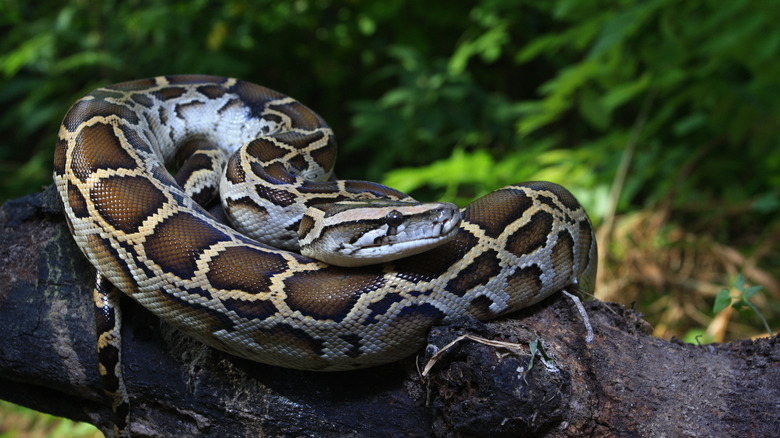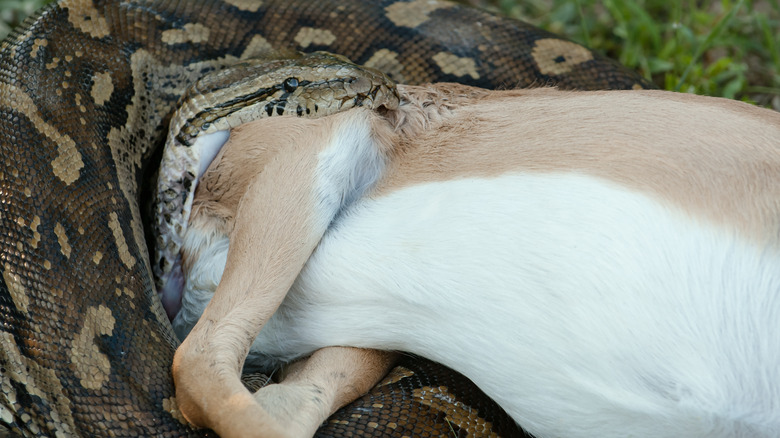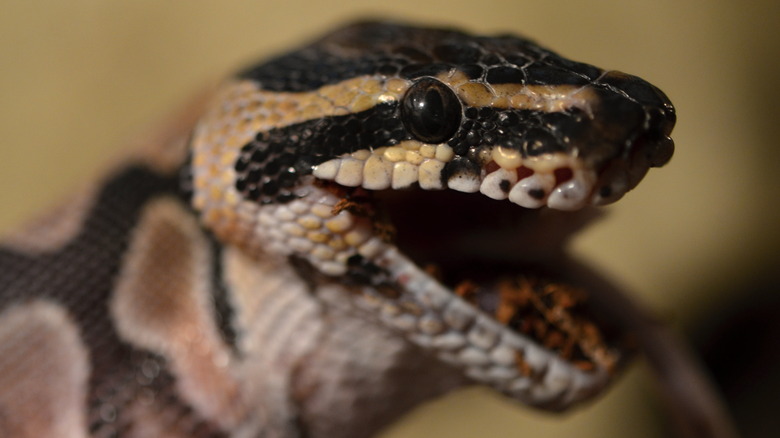We've Been Wrong About How Snakes Eat Their Prey This Whole Time
Did your parents ever tell you not to believe everything you hear? For instance, have you ever heard that snakes unhinge or dislocate their jaws in order to eat prey disproportionate to their body size (via National Geographic)? We're sorry to have to tell you this, but that is one of those things. For a long time people have believed this is how snakes gulp down prey, from small birds to large crocodiles, wallabies, and white tail deer (via Live Science). But it's not true.
Burmese pythons are one type of snake that swallows nearly anything that crosses their path. Between their brutally strong squeezing power and unbelievable ability to open their mouths wider than seemingly possible, they easily take down massive prey. They themselves are huge, with the largest measuring in at about 18 feet and 200 pounds. However, their size is not what gives them the ability to eat such large prey. And it's not because they are dislocating their jaws, either.
Testing the limits
Biologists from the University of Cincinnati were curious about just how wide Burmese pythons could stretch their jaws, and also wanted to observe how they were able to achieve such an amazing feat (via Live Science). The invasive species is plentiful in the Florida Everglades, where they wreak havoc on the local ecosystem, so population control through local hunters occurs regularly. Provided with euthanized specimens through these conservation efforts, these scientists were able to put their curiosity to the test this year.
Snakes have a stretchy piece of connective tissue between their cranial cavity and lower jaw. Rather than having one whole jaw, like humans do, they have two pieces. Although they don't have any joints there to dislocate, as often falsely believed, scientists wanted to test just how far this connective tissue could stretch. Using 3D-printed probes of increasing varying sizes, the largest being greater in width than a 20 gallon bucket at about nine inches in diameter, they tested the specimens. Because they had a limited supply of smaller test subjects, using only animals killed through conservation efforts, just one python weighing about 130 pounds was able to mouth the largest probe. At their biggest, the biologists involved in the study believe a Burmese python could swallow prey with a diameter of up to 30 inches.
Not all snakes are created equal
Known fittingly as "constrictors," pythons and other snakes coil their long bodies around prey, constricting blood flow (via Live Science) until they feel their victim's heart stop (via National Geographic). Then, the snake gulps down their victim whole, regardless if it's been fully executed, and without chewing. Because they lack the ability to chew, snakes can consume incredibly large prey, but it doesn't mean they should. At least not regularly.
Which brings us to Australia, where a 10-foot olive python fought a crocodile and won in 2014. Another snake across the planet risked it all to do the same thing, but with an alligator. The Floridian snake ate an already dead alligator this year, and due to Florida's inhospitable environment to the invasive species, it was not able to digest the beast fast enough before it rotted inside of it, killing the snake and ripping it in half after death.
This tragic fate, however, is not common, as snakes have the instinctive knowledge to not bite off more than they can chew, as well as swallow their prey from the smallest point first, making it easier to handle. Snakes can often handle eating prey 75% to 100% of their size, because of this. Not all snakes are created equal — brown tree snakes are about the same size as Burmese pythons, but most of their meals consist of small animals, like rabbits, foxes, and raccoons. So while snakes are eating with their eyes, they should really be judging their meals by their (two-parted) jaws.


